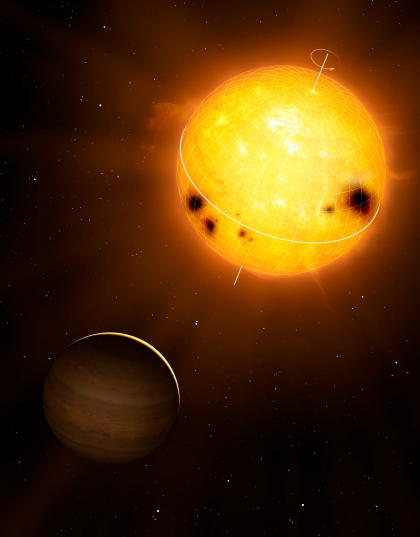
|
Press Release 12/2013
|
 |

|
Press Release 12/2013
|
 |
Press Release 12/2013 - July 29, 2013
A team of scientists led by researchers from the Max Planck Institute for Solar System Research (Germany) and the University of Göttingen (Germany) have for the first time unambiguously measured the internal rotation of a Sun-like star and determined the inclination of its rotation axis. Their calculations show that the star rotates about 2.3 times faster than the Sun, with the axis of rotation inclined at 30 degrees to our line of sight. The star, HD52265, is located more than 90 light years away in the constellation of Monoceros. The results also prove that the body known to accompany the star is indeed an exoplanet and not - as previously argued - a small companion star called a brown dwarf. This is the first time that asteroseismology, the study of a star's internal oscillations, has been used to constrain the mass of an orbiting companion of a Sun-like star. The results will be published this week in the journal "Proceedings of the National Academy of Sciences of the United States of America" (PNAS).
Stars like the Sun support convective motions: hot plasma from the interior rises to the surface, cools, and sinks down again. This process generates pressure (or sound) waves that are trapped in the interior of the star causing it to vibrate like a bell. Asteroseismology uses the surface observations of these oscillations to probe, amongst other quantities, the rotation of stellar interiors.

|
|
Figure 1: Star-planet system HD52265 observed by the COROT satellite. |
|
(Image: Mark A. Garlick / markgarlick.com) |
The team of scientists led by Prof. Dr. Laurent Gizon from the Max Planck Institute for Solar System Research (MPS) and the University of Göttingen used data obtained by the CoRoT space telescope to draw inferences on the internal rotation of HD52265 by studying its global modes of oscillation. This star was observed continuously for 117 days between November 2008 and March 2009. Long uninterrupted observations like these are crucial in order to obtain the necessary precision on the frequencies of oscillation of the star.
"The rotation of the star leaves subtle signatures in the frequencies with which the star vibrates", Gizon explains. Sound waves that propagate in the direction of rotation travel faster than waves that travel against rotation. This leads to a frequency difference that is absent in the hypothetical case of a star without rotation. Furthermore, the visibility of the modes of oscillation depends on which angle the star is viewed from.
Gizon points out that, "The asteroseismic results are remarkably consistent with other independent measurements of the surface rotation of this star". One of the independent techniques measures the rotation of starspots, dark regions on the star's surface. The new results show that in the case of star HD52265 the rotation at the surface and in the interior is very similar. This is also true for the Sun and other Sun-like stars.
It has been known for over ten years that the star HD52265 wobbles due to the presence of an orbiting companion body, HD52265b. Dr. Thorsten Stahn from the University of Göttingen explains "There was, however, an uncertainty as to whether the orbiting companion was a brown dwarf star or an exoplanet because the mass of HD52265b was not known".
The minimum mass of HD52265b was previously estimated using the radial velocity technique, where the star is observed to wobble about a common center of mass due to the gravitational pull of the orbiting companion body. However, the true mass cannot be known unless the inclination of the orbit of the body is known. Asteroseismology can measure the direction of the rotation axis of the star, and thus, under the standard assumption that the stellar rotation axis and the axis of the planetary orbit coincide, the minimum mass of the body can be converted into a true mass. "Our results show that HD52265b has a mass of 1.85 Jupiter masses ruling out the possibility of it being a brown dwarf star", Stahn explains.
These results demonstrate the unique capabilities of asteroseismology to probe the mysteries of stellar interiors and help to characterise orbiting exoplanets. Dr. Hannah Schunker from the MPS adds, "This raises the question: how did such a huge planet come to exist so close to its star? The inclination of the stellar rotation axis is additional information about the star-planet system that may help us to decide which stellar-system formation and evolution scenario is more likely".
This research was carried out as a part of the Collaborative Research Center 963 "Astrophysical Flow Instabilities and Turbulence" funded by the German Research Foundation and involving 11 German institutes in the Göttingen neighbourhood. The project "Asteroseismology and dynamos in solar-like stars" is led by Prof. Dr. Laurent Gizon and Dr. Hannah Schunker.
Gizon et al.:
Seismic constraints on rotation of Sun-like star and mass of exoplanet,
Proceedings of the National Academy of Sciences of the United States of America (PNAS), Early Edition, 29. Juli 2013
doi:10.1073/pnas.1303291110
![]() Collaborative Research Center 963 "Astrophysical Flow Instabilities and Turbulence"
Collaborative Research Center 963 "Astrophysical Flow Instabilities and Turbulence"
![]() Project A18
Project A18
![]() CoRoT-Homepage
CoRoT-Homepage
Prof. Dr. Laurent Gizon
Max Planck Institute for Solar System Research and
Institute for Astrophysics, University of Göttingen
Max-Planck-Straße 2
37191 Katlenburg-Lindau
Tel.: +1 212 992 75 46
Email: gizon![]() mps.mpg.de
mps.mpg.de
Dr. Birgit Krummheuer
Press and Public Relations
Max Planck Institute for Solar System Research
Max-Planck-Straße 2
37191 Katlenburg-Lindau
Tel.: 05556 979 462
Fax: 05556 979 240
Mobil: 0173 3958625
Email: krummheuer![]() mps.mpg.de
mps.mpg.de
| © 2009, Max Planck Institute for Solar System Research, Lindau |
Presseinfo 29-07-2013 |